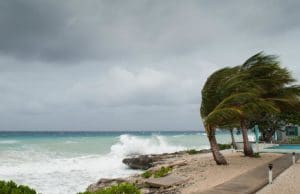
With the Atlantic hurricane season on the horizon, builders and architects might be especially concerned with hurricane windows which are made to withstand the strong winds, rain, and debris of hurricanes and other major storms.
While it can be beneficial to include wind and impact-resistant windows in a variety of structures, it’s actually required in some areas of the U.S. Currently, buildings located within one mile of the coast in hurricane-prone regions are required to have windows in place to protect from wind-borne debris. There are different levels of guidance codes that fit the requirements of specific states and organizations. For example, ‘Miami Dade windows’ need to withstand a 9-lb. 2×4 traveling 348 ft at 34 mph. Below is a list of the different guidance codes and their requirements:
- Miami Dade – 9lb. 2×4 @ 34mph – 348 FT-LB
- Florida Building Code – 9lb. 2×4 @ 54mph – 910 FT-LB
- Florida State Shelter Program – 15lb. 2×4 @ 50mph – 1,254 FT-LB
- ICC-500 – 9lb. 2×4 @ .4 x DWS (102 max) – 3,132 FT-LB
- FEMA – 9lb. 2×4 @ .5 x DWS (128 max) – 4,932 FT-LB
LEVELS OF PROTECTION FOR HURRICANE WINDOWS
Impact-resistant glazing is a process where two or more window panes are bonded together with a film. If the glass shatters, the pieces will stick to that film and continue to protect from water and debris. There are different levels of protection for hurricane-resistant windows. Tempered glass is a panel that has been treated with heat in order to avoid potentially dangerous fragmenting if the window breaks. Basically, if there is a breakage, the pane will shatter into small pieces rather than fracture into large pieces. This, however, isn’t considered to be impact-resistant glass.
TESTING REQUIREMENTS
The American Society for Testing & Materials (ASTM) has set a standard test method for measuring the performance of exterior windows, doors, hurricane shutters, and other impact-protection systems for buildings located in hurricane-prone areas. A window can be certified as impact-resistant at three different levels. Each level comes with a different requirement for the projectile size and speed to be used in tests, depending on the wind zone of the building location. There are also higher standards set for essential facilities in those areas, like government buildings and public safety shelters. Builders can check with their local associations to find out the exact requirements for their area.
INSTALLATION REQUIREMENTS
The ASTM has also set requirements for the proper installation of hurricane windows. The window manufacturer should provide specific instructions for installation that need to be followed in order to ensure the highest level of protection. It can also be beneficial to find and work with an installer who is familiar with hurricane window installation and the ASTM standards. Detailed information about the requirements can be found in ASTM E2112.
Insulgard impact-resistant glazing products and framing systems are tested and certified at the highest standards ensuring superior protection for buildings exposed to high winds, hurricanes, and other types of serious weather conditions.
INSULGARD IS READY TO HELP SECURE YOUR FACILITY
Insulgard is proud to help companies across the country improve their physical and psychological safety with all types of hurricane windows. To get an expert opinion about what type of impact resistant glass you might need compared to film, design a system, or get a quote, please don’t hesitate to contact us.

